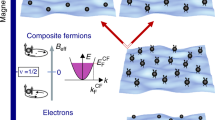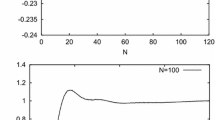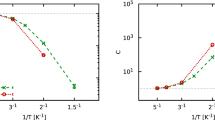Abstract
In this work, we study the exact liquid-solid transition between the Laughlin liquid and the Wigner crystal states in the lowest Landau level at low filling factors. The incompressible quantum fluid consists of strongly correlated electrons interacting with a strong magnetic field and cooled at a low temperature. According to composite fermions theory, in principle all fractions are possible. The Laughlin wave function is not particularly accurate at \(\upsilon\) \(\le 1/7\) where the transition from the liquid to crystal occurs. Independent of the model used to estimate the transition temperature, we note that the Wigner crystal phase is expected to exist at such low filling factors based on analytical calculation, into the series of fractional quantum Hall effect (FQHE) liquids prescribed by the composite fermions model.

Similar content being viewed by others
References
Tsui, D.C., Stormer, H.L., Gossard, A.C.: Phys. Rev. Lett. 48, 559 (1982)
Jain, J.K.: Phys. Rev. Lett. 63, 199 (1989)
Jain, J.K.: Composite Fermions. Cambridge University Press, Cambridge (2007)
Jheng, S.-D., Jiang, T.F., Cheng, S.-C.: Phys. Rev. A 88, 051601(R) (2013)
Laughlin, R.B.: Phys. Rev. Lett. 50, 1395 (1983)
Morf, R., Halperin, B.I.: Phys. Rev. Lett. 33, 2221 (1986)
Fano, G., Ortolani, F.: Phys. Rev. Lett. 37, 8179 (1988)
Ammar, M.A., Bentalha, Z., Bekhechi, S.: Condens. Matter. Phys. 19, 33702 (2016)
Ammar, M.A.: Condens. Matter. Physics. 22, 23701 (2019)
Ahmed, Ammar M.: Few-Body Syst 63, 5 (2022)
Wigner, E.P.: Phys. Rev. Lett. 46, 1002 (1934)
Maki, K., Zotos, X.: Phys. Rev. B 28, 4349 (1983)
Levesque, D., Weis, J.J., MacDonald, A.H.: Phys. Rev. B 30, 1056 (1984)
Lam, P.K., Girvin, S.M.: Phys. Rev. B 30, 473 (1984)
Wolfram Research, Inc., Mathematica, Version 4.0 Champaign, Illinois (1999)
Ciftja, O., Wexler, C.: Phys. Rev. 67, 075304 (2003)
Girvin, S.M., MacDonald, A.H., Platzman, P.M.: Phys. Rev. Lett. 54, 581 (1985)
Zhu, X., Louie, Steven G.: Phys. Rev. Lett. 70, 335 (1993)
Yang, K., Haldane, F.D.M., Rezayi, E.H.: Phys. Rev. B 64, 081301(R) (2001)
Pan, W., Stormer, H.L., Tsui, D.C., et al.: Phys. Rev. Lett 88, 176802 (2002)
Gradshteyn, I.S., Ryzhik, I.M.: Table of integrals, series and products. Academic Press, New York (1980)
Acknowledgements
This work is partially supported by the Theoretical Laboratory “Laboratory of Physics of Experimental Techniques and Their Applications(LPTEA),” University of Medea, Algeria. We also thank A. EULDJI for her careful reading of the manuscript.
Author information
Authors and Affiliations
Corresponding author
Ethics declarations
Conflict of Interest
The authors declare no competing interests.
Additional information
Publisher’s Note
Springer Nature remains neutral with regard to jurisdictional claims in published maps and institutional affiliations.
Appendix
Appendix
1.1 The Coulomb Interaction Potential
The wave functions in the lowest Landau level are simple monomials in \(z_{j}\). Thus, let us apply the change \(r_{j}\) \(\rightarrow\) \(z_{j}=x_{j}-i y_{j}=r_{j}\)e\(^{-i\varphi _{j}}, j=1,...,N\). The electron-electron interaction potential
where \({r}_{i}\) (or \({r}_{j}\)) indicates the electron vector position. For a given wave function \(\mathit{\Psi}\), these energies are determined using the following formulae:
The term \(\left\langle \widehat{V}_{ee}\right\rangle\) is written as follows:
The electron-background interaction potential
\(\overrightarrow{r}_{i}\) and \(\overrightarrow{r}\) are background coordinates. \(S_{N}\) is the area of the disk and \(\rho\) is the density of the system defined by
is the electron-background interaction energy and
with
where is the \(J_{n}(x)\) n-th order Bessel functions [21].
The background-background interaction potential
Rights and permissions
Springer Nature or its licensor (e.g. a society or other partner) holds exclusive rights to this article under a publishing agreement with the author(s) or other rightsholder(s); author self-archiving of the accepted manuscript version of this article is solely governed by the terms of such publishing agreement and applicable law.
About this article
Cite this article
Ammar, M.A., Guehlouz, H. & Euldji, A. Exact Liquid-Solid Transition from the Laughlin Liquid State to the Wigner Crystal in the Lowest Landau Level. J Supercond Nov Magn 36, 11–16 (2023). https://doi.org/10.1007/s10948-022-06466-4
Received:
Accepted:
Published:
Issue Date:
DOI: https://doi.org/10.1007/s10948-022-06466-4




